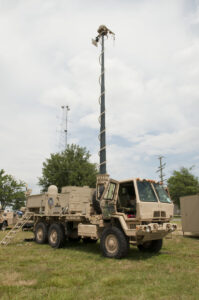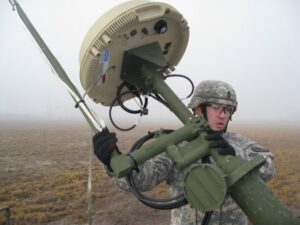Army Plans To Halt WIN-T Buy; Shuffle Network $$
Posted on

Some of the many elements of the Army’s WIN-T battlefield network.
WASHINGTON: After almost a decade of reporting on the Army’s crucial networks, I’d thought they’d started to get things right. Boy, was I wrong.
At a hearing this afternoon of the House Armed Services air and land subcommittee, the Army left lawmakers shaking their heads when they announced they plan to shut down the controversial WIN-T program — except they aren’t really shutting it down: They’re going to keep buying it for a year. They’re also planning to buy other hardware and software that’s not 10 years out of date, as much of the current network equipment is. (See chart below).

Gen. Mark Milley
These decisions are all products of the sweeping review that Chief of Staff Gen. Mark Milley ordered of all the services’ networks, not just WIN-T. Milley sees the current systems as too vulnerable to jamming and hacking, too big a target for artillery, and too immobile for rapid maneuver. Those are tolerable weaknesses against the low-tech Taliban or Islamic State, but crippling in a high-intensity war against Russia or China. Milley faces the risk that, in the next war, the US Army’s communications will get shut down — as the Ukrainian Army’s networks were in 2014, paralyzing them against the Russian invasion.
No wonder, then, that the Army feels a sense of urgency. The problem is they’re asking a frazzled Congress to approve major changes to the fiscal 2018 budget when the legislative process is limping and gasping towards the finish line. (FY18 actually begins Oct. 1st, not that anyone expects Congress to pass spending bills by then.
One of our favorite defense industry analysts, Byron Callan of Capital Alpha, sums it up the legislative state of play crisply (his italics: “The hearing was held because the Army abruptly changed its acquisition strategy after having submitted its FY18 budget and after three of the four primary oversight committees had marked up the FY18 budget…..Its intent is to redirect funding to new aspects of network modernization that have yet to be fully defined….Committee members were not happy about the abrupt change in Army plans.”
Some of the reaction from subcommittee members:

Army WIN-T Tactical Communications Node.
Rep. Jim Langevin, ranking member of the HASC emerging threats and capabilities subcommittee: “This is just a stunning hearing and turn of events.” Army appears to have “squandered” precious dollars in “search of the perfect system.”
Rep. Paul Cook, a retired Marine colonel: “Very very upset. Timing couldn’t be worse right now. A lot of us are trying to get the budget passed and now this happens.”
Rep. Anthony Brown, a new member of the HASC: “Disappointed is just an understatement for me.”
Subcommittee chairman Rep. Michael Turner at the end of the hearing: “This is a very skeptical subcommittee. The information you’ve given us does not justify the abrupt shift… very disappointing.”
How bad is it? In testimony to the committee, Army Lt. Gen. Bruce Crawford, said this: “The Army’s current network was conceived, developed and fielded for the static environments of Iraq and Afghanistan but it does not meet the future warfighting needs of a high-end conflict.”
To help fix this state of affairs,Crawford said, the service “will immediately halt procurement of the Mid-Tier Network Vehicular Radio (MNVR)) and legacy Command Post of the Future (CPOF). The Army will also halt procurement of Warfighter Information Network-Tactical (WIN-T) Increment 2 at the end of FY18.”
The nation has, so far, spent $6 billion developing WIN-T. That money, Crawford and other Army officials told the subcommittee, won’t be squandered because they will deploy “capabilities and elements” of WIN-T 2. — indeed, some brigades already have the system, with the first sets fielded in 2012.

An Army soldier sets up a highband antenna.
Oh, and after spending $6 billion on WIN-T the Army says it needs $545 million, which is not, they say, new money “but a realignment of existing resources” — i.e. a reprogramming, in Congressional parlance. (See chart below). The Army will plan to apply $413.8M to fix the network’s most pressing interoperability and security concerns, and $131.1M to “adapt and buy” better systems. The Army will reinvest the savings from WIN-T Increment 2, MNVR, and CPOF to fix the network by “improving survivability to electronic warfare, cyber capabilities and the mobility of command posts,” Crawford testified.
WIN-T is heavy and took– on average– 40 to 50 hours to get equipment up on air at 16 National Training Center exercises, Crawford said. That’s not exactly the speedy, mobile, adaptable system you’d need on a modern battlefield against, say, the Russians, who can spot a target with drones and have artillery rockets inbound in minutes.
Below is chart outlining just what the Army plans to do, although Crawford said no decision has been made yet — just a plan. Except it’s the Army, so unless someone on the Hill screams very loudly, this is the service’s decision.
|
BLIN |
SSN/APE |
Program Title |
Mark |
BASE/OCO |
|
FY18 OPA |
||||
|
19 |
BW7100 |
WIN-T Ground Forces Tactical Network |
-420,492 |
Base |
|
37 |
B51001 |
Mid-Tier Networked Vehicular Radio |
-25,100 |
Base |
|
102 |
BA9320 |
Maneuver Control System |
-59,900 |
Base |
|
184 |
BS9100 |
Initial Spares |
-23,935 |
Base |
|
FY18 RDTE, A |
||||
|
83 |
0604290A |
Mid-Tier Networked Vehicular Radio (MNVR) |
-10,589 |
Base |
|
229 |
0310349A |
WIN-T Increment 2 – Initial Networking |
-4,723 |
Base |
|
FY18 OPA |
||||
|
21 |
B07100 |
Tactical Network Technology Mod In SVC * |
209,100 |
Base |
|
20 |
B00010 |
Signal Modernization Program |
22,439 |
Base |
|
55 |
B63000 |
Defensive CYBER Operations |
20,000 |
Base |
|
62 |
BU0500 |
Installation Info Infrastructure Mod Program (I3MP) |
57,300 |
Base |
|
166 |
MA9800 |
Generators and Associated Equipment |
15,800 |
Base |
|
NEW |
BW7200 |
Situational Information Transport * |
102,400 |
Base |
|
FY18 RDTE, A |
||||
|
103 |
0604798A |
Brigade Analysis, Integration and Evaluation * |
52,700 |
Base |
|
109 |
0604818A |
Army Tactical Command and Control Hardware & Software * |
55,000 |
Base |
|
137 |
0605380A |
AMF Joint Tactical Radio system (JTRS) * |
10,000 |
Base |
* New Starts
Among the problems with today’s hearing, and the Army’s culture generally, is that they really find it difficult to talk with people who aren’t in the Army — for example, members of Congress. And they want to follow a process, like developing requirements and following the acquisition rules. Of course, that leaves them lagging years behind commercial industry, as Crawford and the other Army officials admitted. They say they’re going to tell industry what they want and let it tell them what’s a good idea. Then they’ll test it. They’ve been “over prescribing” to industry, Crawford told the subcommittee.
Gosh, wasn’t that what the Network Integration Exercises (NIE) were supposed to fix? Let’s hope the Army’s not really as stuck in the mud as today’s hearing made it appear. Our troops need those networks to fight and win.
Subscribe to our newsletter
Promotions, new products and sales. Directly to your inbox.
